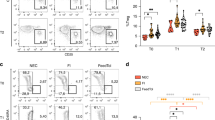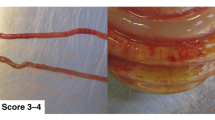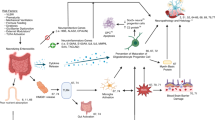Abstract
Background
Necrotizing enterocolitis (NEC) is a severe inflammatory gastrointestinal disease in neonates. We aimed to evaluate the potential of IgG anti-tissue transglutaminase antibodies (IgG tTG) as early biomarkers for NEC.
Method
We conducted a prospective observational study, collecting plasma from 60 neonates with abdominal distension (AD), which were divided into the NEC (n = 30) and the controls (n = 30) according to the follow-up results, and used the autoantigen microarray to identify for NEC-associated autoantibodies. An Enzyme-linked immunosorbent assay (ELISA) was utilized to measure plasma IgG tTG levels in a validation study (NEC n = 43, controls n = 20).
Results
Microarray analysis indicated significantly elevated IgG tTG levels in neonates with NEC compared to controls (P < 0.001). ELISA further confirmed the significant elevation of IgG tTG in neonates with NEC (P < 0.001). IgG tTG effectively distinguished neonates with NEC from the controls, with an area under the curve (AUC) of 0.8674 (sensitivity of 72.09% and specificity of 95%). Encouragingly, IgG tTG levels were significantly higher in neonates with NEC I than in controls (P < 0.001). Additionally, as clinical conditions of neonates with NEC improved, the IgG tTG levels declined (P = 0.0159).
Conclusion
IgG tTG has potential as a biomarker for early diagnosis of NEC and predicting its prognosis after treatment.
Impact
-
Our results demonstrate that IgG anti-tissue transglutaminase antibodies possess significant diagnostic value for NEC.
-
IgG anti-tissue transglutaminase antibodies can serve as a biomarker for early diagnosis NEC and its prognosis of treatment.
-
The relationship between IgG anti-tissue transglutaminase antibodies and immune diseases may shed light on the pathogenesis of NEC, potentially opening new therapeutic avenues for preventing and treating neonates with NEC.
This is a preview of subscription content, access via your institution
Access options
Subscribe to this journal
Receive 14 print issues and online access
$259.00 per year
only $18.50 per issue
Buy this article
- Purchase on SpringerLink
- Instant access to full article PDF
Prices may be subject to local taxes which are calculated during checkout




Similar content being viewed by others
Data availability
Data included in this manuscript are available upon request by contacting the corresponding author and will be freely available to any researcher wishing to use them for non-commercial purposes, without breaching participant confidentiality.
References
Meister, A. L., Doheny, K. K. & Travagli, R. A. Necrotizing enterocolitis: It’s not all in the gut. Exp. Biol. Med. 245, 85–95 (2020).
Flahive, C., Schlegel, A. & Mezoff, E. A. Necrotizing enterocolitis: updates on morbidity and mortality outcomes. J. Pediatr. 220, 7–9 (2020).
Lin, P. W. & Stoll, B. J. Necrotising enterocolitis. Lancet 368, 1271–1283 (2006).
Kim, J. H., Sampath, V. & Canvasser, J. Challenges in diagnosing necrotizing enterocolitis. Pediatr. Res. 88, 16–20 (2020).
Hackam, D. J. & Sodhi, C. P. Bench to bedside - new insights into the pathogenesis of necrotizing enterocolitis. Nat. Rev. Gastroenterol. Hepatol. 19, 468–479 (2022).
Zarrin, A. A., Bao, K., Lupardus, P. & Vucic, D. Kinase inhibition in autoimmunity and inflammation. Nat. Rev. Drug Discov. 20, 39–63 (2021).
Xiao, Z. X., Miller, J. S. & Zheng, S. G. An updated advance of autoantibodies in autoimmune diseases. Autoimmun. Rev. 20, 102743 (2021).
Pisetsky, D. S. Pathogenesis of autoimmune disease. Nat. Rev. Nephrol. 19, 509–524 (2023).
Vidarsson, G., Dekkers, G. & Rispens, T. IgG subclasses and allotypes: from structure toeffector functions. Front. Immunol. 5, 520 (2014).
Šuštić, T. et al. Immunoassay for quantification of antigen-specific IgG fucosylation. EBioMedicine 81, 104109 (2022).
Locatelli, A. et al. Pathology findings in preterm placentas of women with autoantibodies: A case-control study. J. Matern Fetal Neonatal Med. 11, 339–344 (2002).
Kumar, P., Hoppensteadt, D., Prechel, M., Deddish, R. B. & Walenga, J. M. Prevalance of heparin-dependent platelet-activating antibodies in preterm newborns after exposure to unfractionated heparin. Clin. Appl. Thromb. Hemost. 10, 335–339 (2004).
Chen, Y. et al. Plasma anti-myosin autoantibodies in the diagnosis of necrotizing enterocolitis. Eur. J. Pediatr. 182, 5203–5210 (2023).
Sima, L. E., Matei, D. & Condello, S. The outside-in journey of tissue transglutaminase in. Cancer Cells 11, 1779 (2022).
Su, T., Qin, X.-Y. & Furutani, Y. Transglutaminase 2 as a marker for inflammation and therapeutic target in sepsis. Int. J. Mol. Sci. 22, 1897 (2021).
Chessler, S. D., Hampe, C. S., Örtqvist, E., Simonson, W. T. & Bekris, L. Immune reactivity to GAD25 in type 1 diabetes mellitus. Autoimmunity 35, 335–341 (2002).
Comerford, R., Kelly, J., Feighery, C. & Byrne, G. IgG anti-tTG responses in different autoimmune conditions differ in their epitope targets and subclass usage. Mol. Immunol. 67, 369–376 (2015).
Walsh, M. C. & Kliegman, R. M. Necrotizing enterocolitis: treatment based on staging criteria. Pediatr. Clin. North Am. 33, 179–201 (1986).
Mäki, M. Coeliac disease and autoimmunity due to unmasking of cryptic epitopes?. Lancet 348, 1046–1047 (1996).
Chrobok, N. L., Sestito, C., Wilhelmus, M. M. M., Drukarch, B. & van Dam, A. M. Is monocyte- and macrophage-derived tissue transglutaminase involved in inflammatory processes?. Amino Acids 49, 441–452 (2017).
Sjöberg, K. et al. Factor XIII and tissue transglutaminase antibodies in coeliac and inflammatory bowel disease. Autoimmunity 35, 357–364 (2002).
Qureshi, M. H. The correlation between serum anti-tissue transglutaminase (Anti-tTG) antibody levels and histological severity of celiac disease in adolescents and adults: a meta-analysis. Cureus 15, e51169 (2023).
du Pré, M. F. & Sollid, L. M. T-cell and B-cell immunity in celiac disease. Best. Pract. Res. Clin. Gastroenterol. 29, 413–423 (2015).
Tola, M. D. et al. Anti-tissue transglutaminase antibodies in inflammatory bowel disease: new evidence. Clin. Chem. Lab Med. 42, 1092–1097 (2004).
Korponay-Szabo, I. et al. Elevation of IgG antibodies against tissue transglutaminase as a diagnostic tool for coeliac disease in selective IgA deficiency. Gut 52, 1567–1571 (2003).
Leiva, T. et al. Biomarkers of necrotizing enterocolitis in the era of machine learning and omics. Semin. Perinatol. 47, 151693 (2023).
Cuna, A. & Sampath, V. Genetic alterations in necrotizing enterocolitis. Semin. Perinatol. 41, 61–69 (2017).
Maheshwari, A. et al. Cytokines associated with necrotizing enterocolitis in extremely-low-birth-weight infants. Pediatr. Res. 76, 100–108 (2014).
Rusconi, B., Good, M. & Warner, B. B. The microbiome and biomarkers for necrotizing enterocolitis: are we any closer to prediction?. J. Pediatr. 189, 40–47.e2 (2017).
Kim, D. et al. Pilot application of magnetic nanoparticle-based biosensor for necrotizing enterocolitis. J. Proteom. Bioinform. 5, 002 (2015).
Zhou, C. et al. Serum galectin-3 level as a marker for diagnosis and prognosis of neonatal necrotising enterocolitis: a cohort study. Am. J. Transl. Res. 13, 5731–5737 (2021).
Pace, D. et al. Antimicrobial stewardship in neonates with necrotizing enterocolitis: a quality improvement initiative. J. Pediatr. Surg. 58, 1982–1989 (2023).
Roberts, A. G., Younge, N. & Greenberg, R. G. Neonatal necrotizing enterocolitis: an update on pathophysiology, treatment, and prevention. Paediatr. Drugs 26, 259–275 (2024).
Acknowledgements
The authors would like to thank Guangzhou Women and Children’s Medical Center for providing clinical samples. This study was supported by grant from the Scienceand Technology Research Project of Education Department of Jiangxi Province (Grant NO. GJJ2203559), National Natural Science Foundation of China (Grant NO. 82460317), National Natural Science Funds (Grant NO.8217060280), Natural Science Foundation of Guangdong Province (Grant NO.2114050002084), Science and Technology Program of Guangzhou (Grant NO.SL2024A03J01319, SL2024A04J00240), Jiangxi Provincial Children’s Hospital 2024 First Batch Qingmiao Scientific Research Projects (Grant NO.2024JXEYQM02), The Jiangxi Provincial Natural Science Foundation (Grant NO. 20242BAB20357), The Guangdong Basic and Applied Basic Research Foundation (Grant NO. 2024A1515013190), The Guangxi Basic and Applied Basic Research Foundation (Grant NO. 2024JJB140724) and National Natural Science Foundation of China (Grant NO. 82301955).
Author information
Authors and Affiliations
Contributions
Yan Tian was responsible for the writing of the article. Hua Li, Yufeng Liu, and Shuo Chen were responsible for the design of the article. Junjian Lv and Chaoting Lan reviewed the literature and collected clinical samples. Lin Li, Yide Mu, Shengwei Huang, Jiemei Liang, and Liqiong Zhu performed the experiments and collected the data. Chun Yan, Shuchen Huangfu, and Bowen Tian analyzed the data. All authors have reviewed and approved the final manuscript.
Corresponding authors
Ethics declarations
Competing interests
The authors declare no competing interests.
Ethics approval and consent to participate
The authors are accountable for all aspects of the work in ensuring that questions related to the accuracy or integrity of any part of the work are appropriately investigated and resolved. This study was approved by the Medical Ethics Committees of Guangzhou Women and Children’s Medical Center (NO. 2018052406).
Consent for publication
The manuscript has been read and its submission approved by all co-authors. According to the Chinese law, the patients' kin were informed about the inclusion of their anonymized data in the database, and none declined participation.
Additional information
Publisher’s note Springer Nature remains neutral with regard to jurisdictional claims in published maps and institutional affiliations.
Supplementary information
Rights and permissions
Springer Nature or its licensor (e.g. a society or other partner) holds exclusive rights to this article under a publishing agreement with the author(s) or other rightsholder(s); author self-archiving of the accepted manuscript version of this article is solely governed by the terms of such publishing agreement and applicable law.
About this article
Cite this article
Li, H., Lan, C., Chen, S. et al. Necrotizing enterocolitis: diagnosis with plasma IgG anti-tissue transglutaminase antibodies. Pediatr Res (2025). https://doi.org/10.1038/s41390-025-04040-x
Received:
Revised:
Accepted:
Published:
DOI: https://doi.org/10.1038/s41390-025-04040-x



